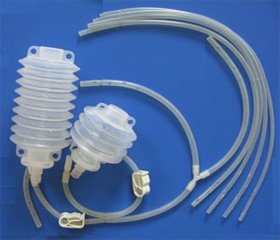Украинский журнал хирургии 4(23) 2013
Вернуться к номеру
Application of drainage – irrigator for intracavitary ultrasonic sanation and draining of wounds
Авторы: A.A. Khristulenko - Donetsk national medical university named after M. Gorky.; Department of general surgery and surgical illnesses of stomatology faculty (Cheef of the departments M.D. Prof. A.V. Borota)
Рубрики: Хирургия
Версия для печати
Lancing of abscess, surgical d-bridement, drainage through surgical wound is used extensively today at the treatment of pyoinflammatory diseases of soft tissues (abscesses, phlegmons, purulent leakage and other). Open drainage is conducive to creation ways of removal wound effluent and creates the obstacle to adhesion of superficial layers of wound. It occupies a special place in minimally invasive interventions under the control of an ultrasound scanner or computer tomography, is an important part of laparoscopic operations.
ultrasound, drainage-irrigator, method of sanation and draining of wound.
Ultrasound is used actively in surgery to reduce trauma, blood loss and pain during operations to speed the healing of surgical wounds and scars resorption.
Disadvantages of known until today drainages devices is the inability to create an effective treatment solution circulation in the wound cavity. Most processes in the wound takes place at the interface between tissue - the drug, wound surface - a layer of pathological microorganisms, living cells - necrotic mass. The interaction is also possible at a shallow depth within the tissues of limited inflammatory shaft. The process of interaction with a drug prevents the layering of fibrin. This process can be represented as a series of steps:
– Approximation of drug molecules to the surface of tissue and contact;
– Penetration of the active substance in the tissue;
– The interaction of drug and the tissue;
– Removal of products from the interaction zone.
New mode of application the two known factors sanation surgical wounds is offered in the article. The pre-production model of drainage – irrigator for intracavitary ultrasonic sanation and draining of wounds developed and passes approbation in a clinic.
Due to the heterogeneity of the structures of the walls of the wound cavity in the proposed device uses a time-varying frequency of the ultrasonic generator. This leads to the absence of a pronounced resonance in the oscillating system, which allows to achieve fragmentation of necrotic tissue sites, regardless of their size, thereby increasing the cleaning effect.
Improve outflow of wound on drainage occurs because larger particles of detritus are crushed and do not block drainage. The contents of the wound cavity often has a gel-like structure under the action of ultrasound, it liquefies and can be easily removed even after a small cross section of the tube.
The advantage of using low-frequency ultrasound energy in our proposed options is its active influence on the basic pathogenesis of the disease. This influence on the diseased tissues of the patient can receive multi-pronged positive effect. Fields of application include the normalization lymphocirculation ultrasound and blood circulation in the tissues, a bactericidal effect on the microflora, antitumor effect, phonophoresis of drugs into tissues.
Application of this device will allow to simplify application of physical methods in treatment and prophylaxis of pyoinflammatory complications of surgical treatment.

